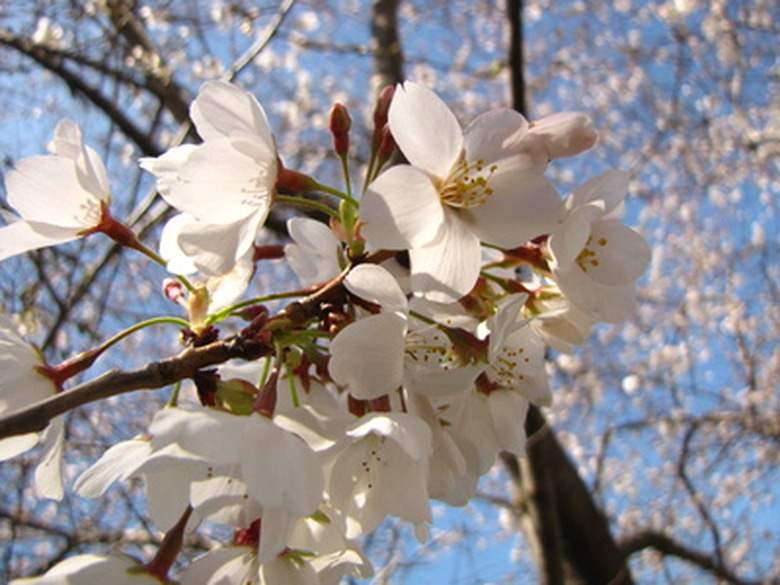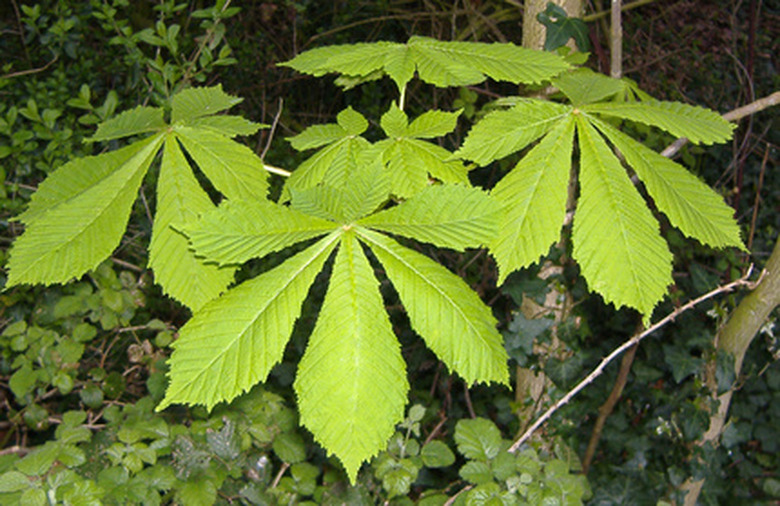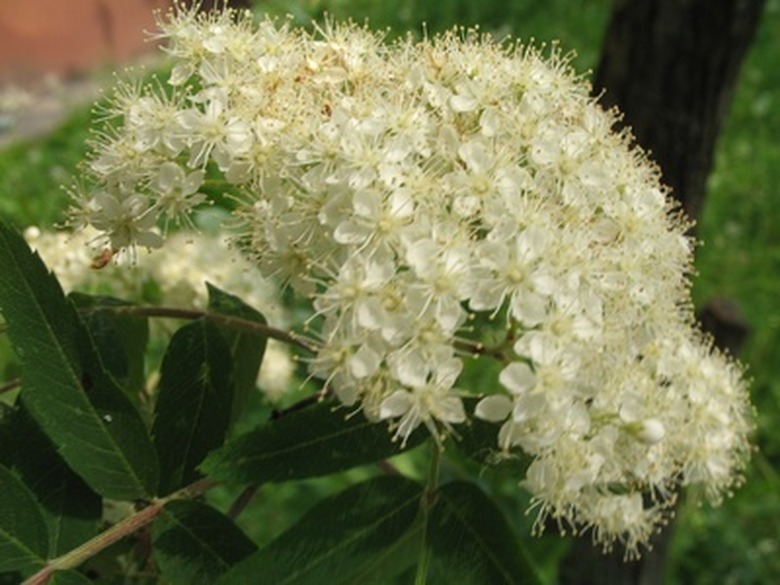How To Identify Flowering Trees In Michigan In June
The flowering trees that are native to Michigan include the Northern catalpa, American basswood, wild black cherry, horse chestnut, flowering dogwood, American mountainash, Eastern redbud, yellow poplar and American mulberry. June is one of the best months to identify these trees growing in Michigan, because you'll be able to study both the flowers and leaves to determine the correct tree species. Although some flowering trees that are native to Michigan begin blooming in the spring, they will still have their flowers in early summer.
Step 1
Identify the Northern catalpa (Catalpa speciosa) by its large, showy, bell-shaped flowers that emerge in late spring and have orange and purple strips or spots. Growing 40 to 70 feet tall and 20 to 40 feet wide with an irregular crown and spreading branches, the Northern catalpa has opposite or whorled, yellowish-green, 6- to 12-inch-wide leaves.
Step 2
Spot the American basswood (Tilia Americana) in Michigan by looking for its pale-yellow flowers growing in multiple-branched clusters and its alternately-arranged, 5- to 6-inch-long leaves that have serrated edges.
Step 3
Look for 4- to 6-inch-long chains of white flower clusters emerging in early spring, followed by small, reddish-black berries in summer, to identify the wild black cherry (Prunus serotina). The wild black cherry tree has a pyramidal to oval shape and grows 50 to 80 feet tall with 2- to 5-inch-long leaves that are alternately arranged along the branches.
- The flowering trees that are native to Michigan include the Northern catalpa, American basswood, wild black cherry, horse chestnut, flowering dogwood, American mountainash, Eastern redbud, yellow poplar and American mulberry.
- Spot the American basswood (Tilia Americana) in Michigan by looking for its pale-yellow flowers growing in multiple-branched clusters and its alternately-arranged, 5- to 6-inch-long leaves that have serrated edges.
Step 4
Study the flowers to spot the horse chestnut (Aesculus hippocastamon). The horse chestnut's flowers are creamy-white with yellow throats and red-speckled centers, forming 5- to 12-inch long clustered panicles. Growing 50 to 75 feet tall and wide with an oval to rounded canopy, the horse chestnut has leaves that are divided into seven lobes.
Step 5
Identify the flowering dogwood (Cornus florida) by its layered, horizontal, low-growing branches and 4-inch-wide white flower bracts that emerge in April. The flowering dogwood grows 15 to 30 feet tall and 15 to 20 feet wide, bearing 3- to 6-inch-long leaves that are arranged opposite each other in pairs along the branches.
Step 6
Spot the American mountainash (Sorbus Americana) growing in Michigan by looking for its short trunk with spreading branches that form a narrow but open, slightly rounded canopy. Growing only 10 to 30 feet in height and width, the mountainash has white flowers and alternately-arranged, 6- to 12-inch-long compound leaves comprised of leaflets that grow from a single stem.
- Study the flowers to spot the horse chestnut (Aesculus hippocastamon).
- The horse chestnut's flowers are creamy-white with yellow throats and red-speckled centers, forming 5- to 12-inch long clustered panicles.
Step 7
Look for rosy-pink, pea-like flowers growing in clusters, followed by 2- to 3-inch-long brown seedpods, to identify the Eastern redbud (Cercis canadensis) in Michigan. Reaching a mature height of 20 to 30 feet and width of 25 to 35 feet, the Eastern redbud has 3- to 5-inch-long, heart-shaped leaves that are arranged alternately along the branches. This tree has a dense, flat-topped to rounded canopy.
Step 8
Identify the yellow poplar (Liriodendron tulipifera), also called the tulip tree or tulip poplar, by its 2- to 3-inch-wide, yellowish-green and orange flowers that grow upright and are cup-shaped. The yellow poplar has a tall, upright trunk with a rounded crown and grows up to 100 feet tall and 40 feet wide. The leaves are alternately-arranged, 6- to 8-inches long with short lobes.
Step 9
Spot the American mulberry or red mulberry (Morus rubra) by looking for its small, pale-green flowers that are 1 to 2 inches long and its alternately-arranged, 3- to 5-inch-long leaves with serrated edges and pale, fuzzy undersides. The red mulberry is a low-branching, smaller tree that has a short trunk and grows up to 60 feet tall at maturity.
- Look for rosy-pink, pea-like flowers growing in clusters, followed by 2- to 3-inch-long brown seedpods, to identify the Eastern redbud (Cercis canadensis) in Michigan.
- Spot the American mulberry or red mulberry (Morus rubra) by looking for its small, pale-green flowers that are 1 to 2 inches long and its alternately-arranged, 3- to 5-inch-long leaves with serrated edges and pale, fuzzy undersides.
Tip
The American basswood, horse chestnut, flowering dogwood, mountainash and yellow poplar trees grow in nearly all parts of Michigan. But the Northern catalpa, American mulberry and Eastern redbud trees are found only in the southern part of the state.
Warning
Although not native to Michigan, you may also see flowering trees like the prairifire flowering crab, the Sargent and snowdrift crabapples, other dogwood species, the Goldenraintree, the Washington Hawthorn, the littleleaf linden, magnolias, the European mountainash (Sorbus aucuparia), pear and plum trees, the Carolina silverbell, the Western sandcherry, and other cherry tree species.


